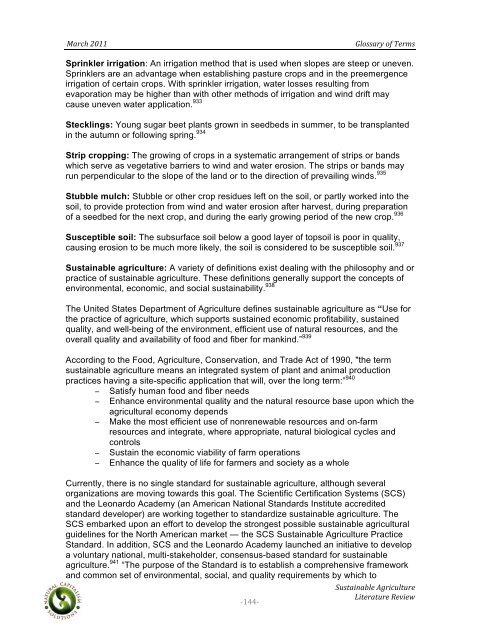Sustainable Agriculture Literature Review - Boulder County
Sustainable Agriculture Literature Review - Boulder County
Sustainable Agriculture Literature Review - Boulder County
You also want an ePaper? Increase the reach of your titles
YUMPU automatically turns print PDFs into web optimized ePapers that Google loves.
! !!<br />
"#$%&!'())!! !!!!!!!!!!!!!!!!!!!!!!!!!!!!!!!!!!!!!!!!!!!!!!!!!!!!!!!!!!!!!!!!I/-44#$F!-J!K1$B4!<br />
Sprinkler irrigation: An irrigation method that is used when slopes are steep or uneven.<br />
Sprinklers are an advantage when establishing pasture crops and in the preemergence<br />
irrigation of certain crops. With sprinkler irrigation, water losses resulting from<br />
evaporation may be higher than with other methods of irrigation and wind drift may<br />
cause uneven water application. 933<br />
Stecklings: Young sugar beet plants grown in seedbeds in summer, to be transplanted<br />
in the autumn or following spring. 934<br />
Strip cropping: The growing of crops in a systematic arrangement of strips or bands<br />
which serve as vegetative barriers to wind and water erosion. The strips or bands may<br />
run perpendicular to the slope of the land or to the direction of prevailing winds. 935<br />
Stubble mulch: Stubble or other crop residues left on the soil, or partly worked into the<br />
soil, to provide protection from wind and water erosion after harvest, during preparation<br />
of a seedbed for the next crop, and during the early growing period of the new crop. 936<br />
Susceptible soil: The subsurface soil below a good layer of topsoil is poor in quality,<br />
causing erosion to be much more likely, the soil is considered to be susceptible soil. 937<br />
<strong>Sustainable</strong> agriculture: A variety of definitions exist dealing with the philosophy and or<br />
practice of sustainable agriculture. These definitions generally support the concepts of<br />
environmental, economic, and social sustainability. 938<br />
The United States Department of <strong>Agriculture</strong> defines sustainable agriculture as “Use for<br />
the practice of agriculture, which supports sustained economic profitability, sustained<br />
quality, and well-being of the environment, efficient use of natural resources, and the<br />
overall quality and availability of food and fiber for mankind.” 939<br />
According to the Food, <strong>Agriculture</strong>, Conservation, and Trade Act of 1990, "the term<br />
sustainable agriculture means an integrated system of plant and animal production<br />
practices having a site-specific application that will, over the long term:” 940<br />
! Satisfy human food and fiber needs<br />
! Enhance environmental quality and the natural resource base upon which the<br />
agricultural economy depends<br />
! Make the most efficient use of nonrenewable resources and on-farm<br />
resources and integrate, where appropriate, natural biological cycles and<br />
controls<br />
! Sustain the economic viability of farm operations<br />
! Enhance the quality of life for farmers and society as a whole<br />
Currently, there is no single standard for sustainable agriculture, although several<br />
organizations are moving towards this goal. The Scientific Certification Systems (SCS)<br />
and the Leonardo Academy (an American National Standards Institute accredited<br />
standard developer) are working together to standardize sustainable agriculture. The<br />
SCS embarked upon an effort to develop the strongest possible sustainable agricultural<br />
guidelines for the North American market — the SCS <strong>Sustainable</strong> <strong>Agriculture</strong> Practice<br />
Standard. In addition, SCS and the Leonardo Academy launched an initiative to develop<br />
a voluntary national, multi-stakeholder, consensus-based standard for sustainable<br />
agriculture. 941 “The purpose of the Standard is to establish a comprehensive framework<br />
and common set of environmental, social, and quality requirements by which to<br />
!<br />
"'**"<br />
!,342#.5#6/1!78$.%3/23$1!<br />
9.21$#23$1!:1;.1
















